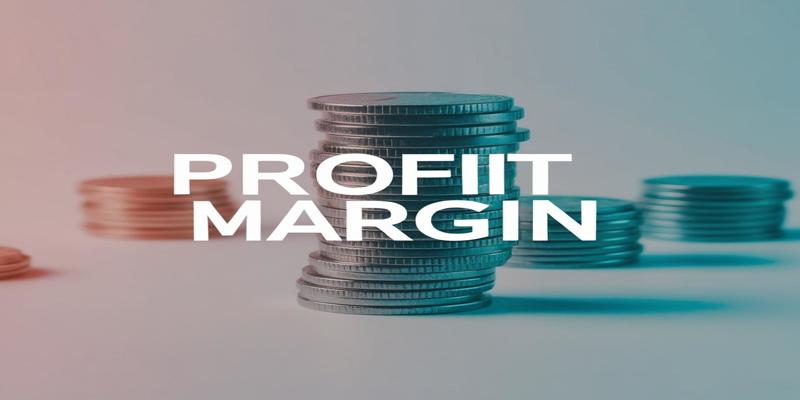Profit Margin Defined
Dec 09, 2024 By Verna Wesley
As a business owner or investor, profit margin is one of the most important ways to gauge your financial health and make informed financial decisions. This key metric demonstrates how healthy revenues are translated into profits, thus offering insight into operational effectiveness and competitive positioning. Learn about the various types of profit margins, how to calculate and interpret them, and their practical applications for business management, investment analysis, and more. Whether you are evaluating your company's performance or considering potential investments, the mastery of profit margin analysis will help you gain a better financial understanding and empower you to make choices based on reality.
Definition of Profit Margin: What It Is and How It's Calculated
 The profit margin is one of the most critical indicators of finance, describing any enterprise's profitability. It is expressed as a percentage and calculated by dividing the net profit by revenue. This strong indicator helps companies assess the health of their financials and make decisions about pricing, costs, and overall strategies.
The profit margin is one of the most critical indicators of finance, describing any enterprise's profitability. It is expressed as a percentage and calculated by dividing the net profit by revenue. This strong indicator helps companies assess the health of their financials and make decisions about pricing, costs, and overall strategies.
Understanding the Components
To fully understand profit margin, one needs to know about its critical components:
- Revenue: The total money one receives from sales, including all expenses.
- Costs: The total expenditure required to produce and sell goods and services.
- Net profit: What remains after deducting all costs from revenue.
Calculation and Interpretation
Fundamental Formula of Profit Margin The basic formula for the calculation of profit margin:
- Profit Margin= (Net Profit /Revenue) x 100
- For example, a business that has generated revenues of $100,000 with a net profit of $20,000 would have a profit margin of 20%. That means that for every dollar that comes in as revenue, the company retains 20 cents as profit.
- The higher the margin, the more profitable, efficient, and healthy the business is. However, what makes up a "good" profit margin can vary depending on an industry and needs to be understood.
Importance to Business Decision-Making
Profit margin is handy in considerable aspects such as the following:
- Comparability of performance to competitors
- Identifying points on which costs can be reduced or revenues can be improved
- Determining the strategy for pricing
- Attractiveness to investors and bank borrowing
Types of Profit Margin: Gross vs. Net vs. Operating
Understanding the various profit margins is critical in analyzing businesses' and investors' financial health and performance. The three common types of profit margins are gross, operating, and net.
Gross Profit Margin
The most straightforward measure of profitability is gross profit margin. It reflects revenues beyond the cost of goods sold for an entity. The gross profit margin is calculated by subtracting COGS from total revenues and dividing by total revenues. This demonstrates how proficient the company is at manufacturing and selling its products.
Operating Profit Margin
Operating Profit Margin: This is otherwise called EBIT margin and depicts operating expenses modified by the COGS. Operating income divided by total revenues gauges it. It reflects the underlying profitability of the firm derived from its core operations by eliminating financing and taxes.
Net Profit Margin
The net profit margin is an all-inclusive measure of profitability since it considers all types of expenses, including COGS, operating expenses, interest, taxes, etc. It is calculated using the formula net income divided by total revenue. The net profit margin shows a company's profit from every dollar it receives in revenue after accounting for all expenses.
Why Profit Margin Matters for Business Success
Leading the Way in Financial Health and Growth
The profit margin is one of the most essential measures conventionally employed to measure a company's profitability. It also shows insight into how a healthy business has translated revenue into profit. Companies can use the level of their profit margins to assess their operational efficiency, pricing policies, and overall competitiveness in the marketplace. A reasonable profit margin would mean the company covers all the costs and has additional money to invest or compensate the shareholders.
Enable Strategic Choice
The knowledge of the profit margin goes a long way in enlightening business leaders on proper decision-making. It helps ascertain which products or services are the most profitable, guiding how resources are allocated and marketed. In this regard, the company is interested in staking its resources on the high-margin offerings while streamlining efficiency in the low-margin areas. Profit margin analysis will help establish pricing strategies, negotiate with suppliers, and assess what will save costs.
Allures investors and finance
Investors and lenders will always respond sensitively to profit margin levels as they reflect financial stability and a further prospect for growth. Good profit margins prove that the enterprise can make earnings on investment, thereby alluring investors. They will further boost a company's creditworthiness for loans or other forms of financing on favorable terms and conditions. Consistent improvement in profit margins would demonstrate sound management and a sustainable business model, further boosting investor confidence.
Benchmarking Performance
These profit margins allow a company's performance company's performance to be benchmarked against the standard in the industry and against that of competitors. Therefore, a firm may tell if it has a relative market advantage or lags. This may point out avenues to enhance operational efficiency, adjust prices, or switch to new market segments to improve profitability.
Investment Evaluation Using Profit Margin Analysis
 Assessing Company Performance
Assessing Company Performance
Therefore, profit margin analysis might be a very good tool for investors to analyze profitability and the efficiency level of their potential investment. Profit margins allow investors to get an informed view of a company's operational success and final profits. Usually, the higher the profit margins, the better the company is at keeping costs under control and earning high returns, implying it will be a good investment opportunity.
Industry Comparison
One key benefit of profit margin analysis as an investment tool is the ability to compare firms within the same industry. Investors can identify, from this comparison, those companies that are bound to take a lead in the industry and those that are likely to underperform. This helps in more cautious investment and realization of value or growth opportunities.
Identifying Trends and Sustainability
These will help the investor observe company profit trends over time. A sustained upward trend in profit margins may indicate good management and successful competitive positioning. In cases where profit margins are on the decline, some of the challenges that could have been faced include increased competition or higher costs. Investors can analyze these trends, evaluate a company's profitability sustainability, and anticipate its future performance.
Assess Risk and Reward
It also powerfully communicates the risk versus return profile of investment. High-profit margin companies can easily engage in more financial flexibility and are also better equipped to face economic headwinds. However, too high a margin may also indicate vulnerability to new entry and regulatory scrutiny. Taken with other financials, investors can better decide how to balance their choices to fit their risk appetite and investment objectives.
Conclusion
Understanding profit margins is fundamental to business success and intelligent investment decisions. One can make valuable conclusions regarding a company's profitability and operational effectiveness from gross, operating, and net profit margin analysis. As a business owner or investor, once you master profit margin analysis, you will be in a position to confidently and precisely navigate what could otherwise be an incredibly complicated world of finance.








